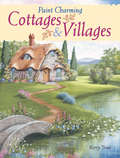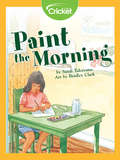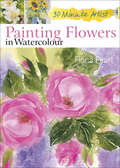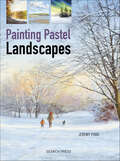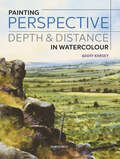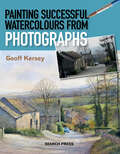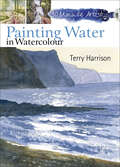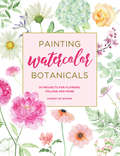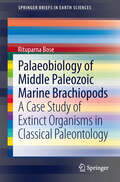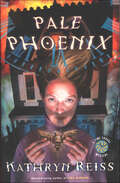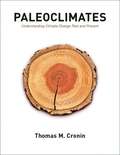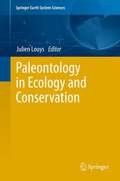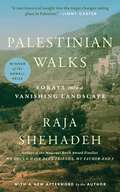- Table View
- List View
Pagan Portals - God-Speaking
by Judith O'GradyPagan Portals - God-Speaking offers a new concept in Earth ecology incorporating mysticism and folk religion. The author is both a trance seer and a biologist, bringing a unique balance to an examination of nature philosophy. Storytelling examples from Irish folklore, NeoPagan theology, and scientific observations all contribute to a carefully reasoned theory about the future of the Earth and ourselves.
Pagan Portals - Sacred Landscape: Caves and Mountains: A Multi-Path Exploration of the World Around Us
by Melusine DracoMountains form the most spectacular creations on the planet and cover such a large amount of Earth&’s landmass that they can be seen clearly from outer space. Mountains are also a reminder that humans count for nothing in the greater scheme of things. They were formed by tectonic plate upheavals of such magnitude that the fossilised remains of prehistoric sea-creatures can be found on mountains tops; in fact, many Himalayan rocks were originally sediments on the primordial Tethys Ocean floor. In this first of the Sacred Landscape series Melusine Draco looks at ways of connecting with the genii locorum that inhabit the caves and mountains of our world. A companion volume to Sacred Landscape: Groves and Forests and Sacred Landscape: Lakes and Rivers.
Paint Charming Cottages & Villages
by Kerry TroutCapture the Charm of Cottage and Village ScenesBring the storybook cottages and towns of your dreams to life. Ten step-by-step projects show you how to paint a variety of architectural styles from a Victorian "gingerbread" house, to an English Tudor cottage, to a Cape Cod and a classic farmhouse. Two nostalgic village scenes take you back to simpler days of main streets lined with merchants, dress shops and tearooms.Dozens of quick mini-demonstrations show you how to embellish your scenes with quaint details, including porch swings, lace curtains, fountains, old-time lampposts, picket fences and quilts fluttering on a clothesline. You'll also learn how to add the seasonal touches of fall foliage, spring flowers and winter snows.Each project is painted with acrylic paints. Full-color photos, traceable patterns, color swatches, detailed materials lists and a techniques section make each painting easy to do. Use your paintbrush and these projects to create your own quaint getaway cottages today!
Paint the Morning
by Sandi TakayamaMalia is not interested in drawing monsters or sculpting pots. All she wants to do is paint the morning.
Painted Botanical Collage: Create Flowers, Succulents, and Herbs from Cut Paper and Mixed Media
by Tracey EnglishWith Painted Botanical Collage, artists of all skill levels will learn to create lifelike botanical artwork—featuring flowers, succulents, and herbs—using painted background papers and elegant collage techniques. A unique technique book, Painted Botanical Collage will show you how to create your own collage materials. This guide takes you step by step through creating mixed-media painted papers, then using them—along with tissue paper, art papers, and found paper, such as magazines—to create perfect collage materials. Cut these decorative papers into plant and flower parts to assemble your designs, adding details using various media.Working from nature is central to this technique—look closely at the palettes and shapes in actual flowers to create realistic stylized representations. Painted Botanical Collage includes instruction on creating flowers, cacti, succulents, leaves, and other popular botanicals—over 30 beautiful designs in all. Join in the fun as British artist Tracey English shares the methods behind the magical flower collages that charm and delight her Instagram followers.
Painter's Quick Reference Birds & Butterflies: Birds And Butterflies
by Editors of North Light BooksThe perfect reference for painters! Brighten your paintings with colorful birds and butterflies. Inside you'll find more than 40 step-by-step demonstrations to help you accurately render beautiful butterflies and a wide variety of songbirds, water birds and exotic birds including goldfinches, hummingbirds, cardinals, mallards and peacocks. You'll also learn how to embellish your paintings with individual feathers, eggs and a nest. This special guide features painting instruction and advice from 11 professional artists working in acrylics, watercolors, oils and colored pencils. Each demonstration includes a detailed materials list to make it even easier for you follow along. This invaluable combination of in-depth painting demonstrations and inspiring ideas is guaranteed to bring you success in all your work.
Painting Flowers in Watercolour (30 Minute Artist)
by Fiona PeartGot a half hour? Use it to paint something beautiful with these ten quick projects.The 30 Minute Artist series is for beginners and busy artists who want to achieve great paintings in just half an hour. Here, expert artist and teacher Fiona Peart helps you build skills and confidence, and loosen up your style, by producing spontaneous, lively flower paintings in thirty minutes flat. Discover quick exercises to get you started—and then try the ten fantastic step-by-step projects, from a jug of daffodils to sunflowers to spring violas—for a delightful creative break in your day.
Painting Indiana III: Heritage of Place (Painting Indiana)
by Indiana Plein Air Painters Association, Inc. Indiana Landmarks&“A visual testament to the quiet, past-haunted beauty of the Indiana environment, both natural and man-made.&” —Bloom The work of T. C. Steele, William Forsyth, J. Ottis Adams, Otto Stark, and Richard Gruelle, known collectively as the Hoosier Group, established plein air (&“in the open air&”) painting as a major art form in Indiana. The vitality of this style is represented in Painting Indiana III: Heritage of Place, which includes one hundred juried works by current Indiana plein air artists, along with paintings by the Hoosier Group, all featuring notable Indiana landmarks. This richly illustrated book will delight Hoosiers and art lovers around the world.
Painting Pastel Landscapes
by Jeremy FordWritten by pastel expert and former S.A.A President Jeremy Ford, this gorgeous book is packed full of chalk pastel techniques and inspiring step-by-step projects. It starts with the basics, such as mark-making and blending, through using colour and tone and creating skyscapes, to more advanced techniques including successfully creating depth and perspective. The book builds in difficulty, interspersing the tips and techniques with five beautiful step-by-step projects, allowing the reader to either dip in and out of the book for inspiration, or to follow the book as a course to build up their skills. A wide range of Jeremy’s inspiring work is shown throughout the book to inspire and encourage the reader.
Painting Perspective, Depth & Distance in Watercolour: Depth And Distance (Watercolour Painting Tips And Techniques Ser.)
by Geoff KerseyThe master watercolourist shares essential techniques for adding depth and realism to your watercolour paintings in this accessible guide.In Perspective Depth and Distance, watercolourist and teacher Geoff Kersey demonstrates how to use line, tone, colour, and detail to create captivating landscapes. With this practical guide, you will learn to capture the beauty of mist-draped mountains and dense woodlands. You will also learn to paint boats, buildings, and natural features that seem to recede into the distance. This volume includes seven step-by-step projects with inspiration and ideas for your own original landscapes. It also features techniques for linear and aerial perspective.
Painting Successful Watercolours from Photographs
by Geoff KerseyLearn the essential techniques for painting from photographs with this illustrated guide by the acclaimed artist and teacher.Many artists enjoy using photographic reference material, but while there are many advantages to this way of working, there are also unique challenges. One must learn to choose what to leave out, what to keep in, and how to adapt the scene to create a painting. In this book, Geoff Kersey introduces twenty-seven of his own paintings, explaining how they evolved from one or more photographs.Kersey includes photographs, sketches, diagrams, details, colour charts and a wealth of tips explaining his techniques and artistic process. This volume also includes a glossary of painting terms as well as photographs for readers to interpret for themselves.
Painting Water in Watercolour (30 Minute Artist)
by Terry Harrison“From beach scenes to ponds, rivers to seas, puddles and streams, Terry shows how to paint water in all its beautiful painterly effects.” —Karen Platt, yarnsandfabrics.co.ukAll watercolour landscape artists need to know how to paint water, and in this book Terry Harrison excels in demystifying the painting process. Here he shares his expert advice and no-nonsense tips and techniques for producing quick, effective paintings of water. There are two or three-step exercises for painting water in all its varied moods and situations, including ripples, reflections, puddles, streams, breaking waves, choppy water, surf, bridges, riverbeds, boats, and much more. There are then ten step-by-step demonstrations that can be produced in half an hour: a misty lake, track with puddles, ford, waterfall, lazy river, stormy sea, cliffs, fisherman, sunset estuary and fishing boat.Essential painting skills conveyed through quick, lively studiesExpert art tuition from a renowned artist, for beginners, the busy artist, or those wanting to loosen up their painting styleNumerous quick exercises and ten step-by-step demonstrations in a handy, affordable ebook format“Terry demonstrates twenty-three basic exercises to build your confidence with the subject from rippled reflections to crashing waves, fast-flowing streams to sun setting on the sea.” —The Leisure Painter
Painting Watercolor Botanicals: 34 Projects For Flowers, Foliage And More
by Harriet de WintonLearn to create your own beautiful watercolor botanical art with more than 30 projects, as well as information on materials and basic techniques. The graceful, contemporary style of these flowers and foliage is attractive and accessible to all no matter your skill level.
Painting Watercolors on Location
by Tom HillA comprehensive workshop approach presented by a master watercolorist, this guide features 11 step-by-step demonstrations filled with valuable methods and techniques for achieving striking on-site watercolor compositions. Beautiful examples and locations — including the Greek island of Santorini, a desert oasis, and a Midwest farmhouse — provide a wealth of inspiration as author and artist Tom Hill demonstrates how to paint intelligently, selectively edit a scene, and more.Painting Watercolors on Location shows developing artists not only how to acquire better understanding and techniques for painting on location but also how to incorporate these helpful practices into their everyday routines. Suitable for art students and artists at the intermediate level and up, these pointers include suggestions for choosing the correct on-site equipment, rendering accurate drawings, selecting and mixing colors, forming textures, and other methods for creating exciting and expressive watercolor paintings.
Painting Wildlife Step by Step: Learn from 50 demonstrations how to capture realistic textures in watercolor, oi l and acrylic
by Rod LawrenceEasy-to-follow, step-by-step demonstrations in acrylic, watercolor and oil Inside, you'll learn how to create realistic wildlife paintings, step by step, mastering dozens of specific wildlife textures, including: Fur of a bobcat, American bison, snow leopard cub and wolf Feathers of a wood duck, white-throated sparrow and northern shoveler Scales of a trout and sunfish Ears of a cottontail rabbit, white-tailed deer and red fox Bills and Muzzles of a northern cardinal, mallard, great blue heron and mountain lion Tails and Feet of a red squirrel, ruffled grouse and blue jay Antlers and Horns of a deer, moose, bighorn sheep and pronghorn White and Black Subjects such as a polar bear, tundra swan and Canada goose Through, you'll benefit from Rod Lawrence's years of wildlife painting experience. He'll help you notice, for example, the way hair and feature textures change on different parts of an animal's body through the seasons - and even according to the age of the animal. Use this heightened awareness, along with the easy-to-follow, step-by-step demonstrations inside, to create more realistic, more sensitive wildlife paintings.
Painting the Inhabited Landscape: Fitz H. Lane and the Global Reach of Antebellum America
by Margaretta M. LovellThe impulse in much nineteenth-century American painting and culture was to describe nature as a wilderness on which the young nation might freely inscribe its future: the United States as a virgin land, that is, unploughed, unfenced, and unpainted. Insofar as it exhibited evidence of a past, its traces pointed to a geologic or cosmic past, not a human one. The work of the New England artist Fitz H. Lane, however, was decidedly different.In this important study, Margaretta Markle Lovell singles out the more modestly scaled, explicitly inhabited landscapes of Fitz H. Lane and investigates the patrons who supported his career, with an eye to understanding how New Englanders thought about their land, their economy, their history, and their links with widely disparate global communities. Lane’s works depict nature as productive and allied in partnership with humans to create a sustainable, balanced political economy. What emerges from this close look at Lane’s New England is a picture not of a “virgin wilderness” but of a land deeply resonant with its former uses—and a human history that incorporates, rather than excludes, Native Americans as shapers of land and as agents in that history.Calling attention to unexplored dimensions of nineteenth-century painting, Painting the Inhabited Landscape is a major intervention in the scholarship on American art of the period, examining how that body of work commented on American culture and informs our understanding of canon formation.
Painting the White House Green: Rationalizing Environmental Policy Inside the Executive Office of the President
by Jason F. Shogren Randall LutterPresidents, like kings, lead cloistered lives. Protecting the president from too much isolation are advisers and aides who help ensure that the administration achieves its policy goals while enjoying broad political support. In economics and environmental policy, where disagreement among stakeholders and expert opinion is especially strong, the president needs good advice about political strategy, as well as unbiased information about the substance of policy issues. It is the latter need that the Council of Economic Advisers (CEA) is intended to address. Painting the White House Green collects personal essays by eight Senior Staff Economists for Environmental and Natural Resource Policy who worked within the CEA from 1992 to 2002. These authors confirm the council's 'severe' view of many environmental initiatives, a perspective that led President Clinton to label his economic advisers as 'lemon suckers.' At the same time, they demonstrate that the emphasis on efficiency was to offer more effective environmental protection at lower cost. Thinking 'green' meant thinking consistently about both economics and the environment. The essays in this innovative book present lively debates on clean air, climate change, and electricity deregulation that pitted economists at CEA, the Office of Management and Budget, and often the Treasury Department, against political advisers in the White House and officials at EPA and other agencies. The essays present vivid portraits of the power plays involved in environmental policymaking, rare insights into presidential decisionmaking, and revealing details of the ways that economic thinking influences-or is neglected-in a wide range of policy decisions.
Palaeobiology of Middle Paleozoic Marine Brachiopods
by Rituparna BoseFossil species appear to persist morphologically unchanged for long intervals of geologic time, punctuated by short bursts of rapid change as explained by the Ecological Evolutionary Units (EEUs). Here, morphological variation in Paleozoic atrypide morphology at the subfamily level (Atrypinae and Variatrypinae) from the Silurian and Devonian time intervals in the third Paleozoic EEU (~444-359 my) were investigated using relatively new techniques of quantitative modeling. The study explains how a group of closely related taxa in atrypide subfamilies exhibit morphological conservation through time in P3 EEU within the Eastern North America region.
Palaeoecology of Africa and the Surrounding Islands - Volume 26 (Palaeoecology Of Africa Ser.)
by L. Scott A. Cadman R. VerhoevenThis volume offers comprehensive and up-to-date information on research in many different disciplines which give an overall insight into the environmental history of Africa.
Pale Phoenix (Time Travel Mysteries)
by Kathryn ReissMiranda isn't happy when sullen orphan Abby Chandler comes to live with her family. But Miranda's anger turns to shock when she learns the girl's horrible secret: Abby's parents and sisters were killed in a house fire in this very town--more than three hundred years ago. Somehow Abby survived the fire and has been living in a virtual limbo ever since. Fifteen-year-old Miranda Browne, the extraordinary protagonist from Kathryn Reiss's first novel, Time Windows, returns for a new time-travel adventure.
Paleoclimates: Understanding Climate Change Past and Present
by Thomas CroninThe field of paleoclimatology relies on physical, chemical, and biological proxies of past climate changes that have been preserved in natural archives such as glacial ice, tree rings, sediments, corals, and speleothems. Paleoclimate archives obtained through field investigations, ocean sediment coring expeditions, ice sheet coring programs, and other projects allow scientists to reconstruct climate change over much of earth's history. When combined with computer model simulations, paleoclimatic reconstructions are used to test hypotheses about the causes of climatic change, such as greenhouse gases, solar variability, earth's orbital variations, and hydrological, oceanic, and tectonic processes. This book is a comprehensive, state-of-the art synthesis of paleoclimate research covering all geological timescales, emphasizing topics that shed light on modern trends in the earth's climate. Thomas M. Cronin discusses recent discoveries about past periods of global warmth, changes in atmospheric greenhouse gas concentrations, abrupt climate and sea-level change, natural temperature variability, and other topics directly relevant to controversies over the causes and impacts of climate change. This text is geared toward advanced undergraduate and graduate students and researchers in geology, geography, biology, glaciology, oceanography, atmospheric sciences, and climate modeling, fields that contribute to paleoclimatology. This volume can also serve as a reference for those requiring a general background on natural climate variability.
Paleontology in Ecology and Conservation
by Julien LouysThe fossil record contains unique long-term insights into how ecosystems form and function which cannot be determined simply by examining modern systems. It also provides a record of endangered species through time, which allow us to make conservation decisions based on thousands to millions of years of information. The aim of this book is to demonstrate how palaeontological data has been or could be incorporated into ecological or conservation scientific studies. This book will be written by palaeontologists for modern ecologists and conservation scientists. Manuscripts will fall into one (or a combination) of four broad categories: case studies, review articles, practical considerations and future directions. This book will serve as both a 'how to guide' and provide the current state of knowledge for this type of research. It will highlight the unique and critical insights that can be gained by the inclusion of palaeontological data into modern ecological or conservation studies.
Palestine - Peace by Piece: Transformative Conflict Resolution for Land and Trans-boundary Water Resources
by Ahmed AbukhaterThis book draws lessons and conclusions, based on the methodology outlined in the author's previous book, Water as a Catalyst for Peace (Routledge, 2013), and further charts the course to a more practical framework for achieving regional stability and justice. Past agreements are examined and analysed, outlining the change along the way that occurred to the land and people of Palestine. The book is written with the intention of exposing past events that led to the current situation, evaluating the current state of the conflict in light of new circumstances and the reality on the ground. Viable options are explored to seek a practical and satisfactory negotiated settlement that ensures justice and viability. In conclusion, a roadmap for future direction is proposed to achieve equitable water allocation through proper negotiation between Israel and Palestine and to ultimately settle the conflict. Water resources allocation is at the heart of this pragmatic framework and roadmap.
Palestinian Walks: Forays into a Vanishing Landscape
by Raja Shehadeh&“A rare historical insight into the tragic changes taking place in Palestine.&” —Jimmy Carter From one of Palestine&’s leading writers, a lyrical, elegiac account of one man&’s wanderings through the landscape he loves—once pristine, now forever changed by settlements and walls—updated with a new afterword by the author.&“I often come to walk in these hills,&” I said to the man who was doing all the talking and seemed to be the commander. &“In fact I was once here with my wife, it was 1999, and some of your soldiers shot at us.&” &“It was over on that side,&” the soldier pointed out. &“I was there,&” he said, smiling. When Raja Shehadeh first started hill walking in Palestine, in the late 1970s, he was not aware that he was traveling through a vanishing landscape. In recent years, his hikes have become less than bucolic and sometimes downright dangerous. That is because his home is Ramallah, on the Palestinian West Bank, and the landscape he traverses is now the site of a tense standoff between his fellow Palestinians and settlers newly arrived from Israel. In this original and evocative book, we accompany Raja on six walks taken between 1978 and 2006. The earlier forays are peaceful affairs, allowing our guide to meditate at length on the character of his native land, a terrain of olive trees on terraced hillsides, luxuriant valleys carved by sacred springs, carpets of wild iris and hyacinth and ancient monasteries built more than a thousand years ago. Shehadeh's love for this magical place saturates his renderings of its history and topography. But latterly, as seemingly endless concrete is poured to build settlements and their surrounding walls, he finds the old trails are now impassable and the countryside he once traversed freely has become contested ground. He is harassed by Israeli border patrols, watches in terror as a young hiking companion picks up an unexploded missile and even, on one occasion when accompanied by his wife, comes under prolonged gunfire. Amid the many and varied tragedies of the Middle East, the loss of a simple pleasure such as the ability to roam the countryside at will may seem a minor matter. But in Palestinian Walks, Raja Shehadeh's elegy for his lost footpaths becomes a heartbreaking metaphor for the deprivations of an entire people estranged from their land.



